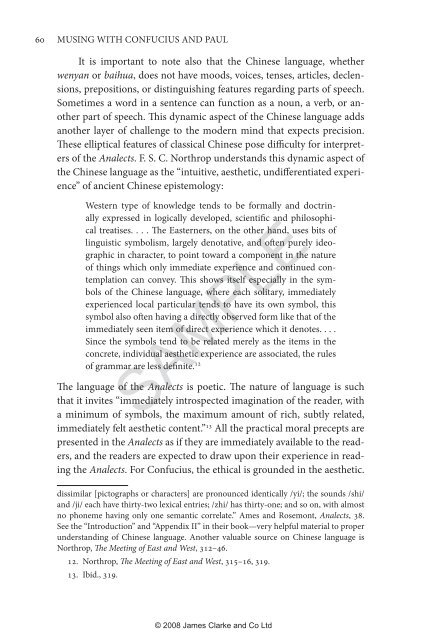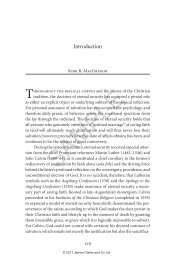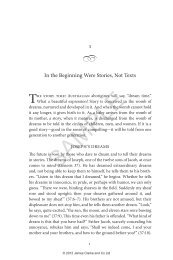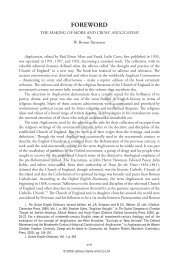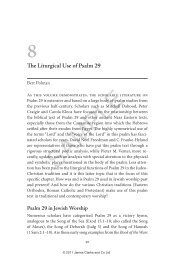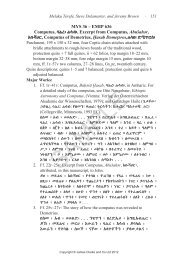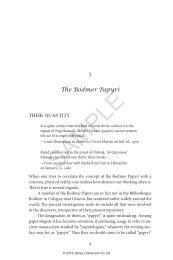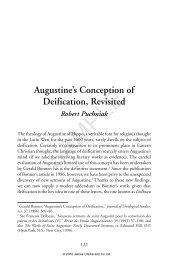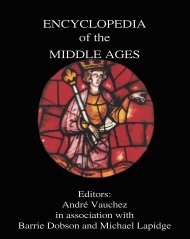Extract from Chapter 1 - James Clarke and Co Ltd
Extract from Chapter 1 - James Clarke and Co Ltd
Extract from Chapter 1 - James Clarke and Co Ltd
You also want an ePaper? Increase the reach of your titles
YUMPU automatically turns print PDFs into web optimized ePapers that Google loves.
60 MUSING WITH CONFUCIUS AND PAUL<br />
It is important to note also that the Chinese language, whether<br />
wenyan or baihua, does not have moods, voices, tenses, articles, declensions,<br />
prepositions, or distinguishing features regarding parts of speech.<br />
Sometimes a word in a sentence can function as a noun, a verb, or another<br />
part of speech. This dynamic aspect of the Chinese language adds<br />
another layer of challenge to the modern mind that expects precision.<br />
These elliptical features of classical Chinese pose difficulty for interpreters<br />
of the Analects. F. S. C. Northrop underst<strong>and</strong>s this dynamic aspect of<br />
the Chinese language as the “intuitive, aesthetic, undifferentiated experience”<br />
of ancient Chinese epistemology:<br />
Western type of knowledge tends to be formally <strong>and</strong> doctrinally<br />
expressed in logically developed, scientific <strong>and</strong> philosophical<br />
treatises. . . . The Easterners, on the other h<strong>and</strong>, uses bits of<br />
linguistic symbolism, largely denotative, <strong>and</strong> often purely ideographic<br />
in character, to point toward a component in the nature<br />
of things which only immediate experience <strong>and</strong> continued contemplation<br />
can convey. This shows itself especially in the symbols<br />
of the Chinese language, where each solitary, immediately<br />
experienced local particular tends to have its own symbol, this<br />
symbol also often having a directly observed form like that of the<br />
immediately seen item of direct experience which it denotes. . . .<br />
Since the symbols tend to be related merely as the items in the<br />
concrete, individual aesthetic experience are associated, the rules<br />
of grammar are less definite. 12<br />
The language of the Analects is poetic. The nature of language is such<br />
that it invites “immediately introspected imagination of the reader, with<br />
a minimum of symbols, the maximum amount of rich, subtly related,<br />
immediately felt aesthetic content.” 13 All the practical moral precepts are<br />
presented in the Analects as if they are immediately available to the readers,<br />
<strong>and</strong> the readers are expected to draw upon their experience in reading<br />
the Analects. For <strong>Co</strong>nfucius, the ethical is grounded in the aesthetic.<br />
SAMPLE<br />
dissimilar [pictographs or characters] are pronounced identically /yi/; the sounds /shi/<br />
<strong>and</strong> /ji/ each have thirty-two lexical entries; /zhi/ has thirty-one; <strong>and</strong> so on, with almost<br />
no phoneme having only one semantic correlate.” Ames <strong>and</strong> Rosemont, Analects, 38.<br />
See the “Introduction” <strong>and</strong> “Appendix II” in their book—very helpful material to proper<br />
underst<strong>and</strong>ing of Chinese language. Another valuable source on Chinese language is<br />
Northrop, The Meeting of East <strong>and</strong> West, 312–46.<br />
12. Northrop, The Meeting of East <strong>and</strong> West, 315–16, 319.<br />
13. Ibid., 319.<br />
© 2008 <strong>James</strong> <strong>Clarke</strong> <strong>and</strong> <strong>Co</strong> <strong>Ltd</strong>


